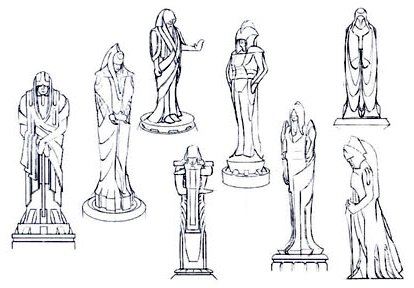Faya Rodemos, a controversial philosopher and lawmaker, stood as one of the esteemed Four Sages of Dwartii, whose influence shaped the early legal framework of the Galactic Republic. Approximately a millennium after the Republic's establishment, a bronzium sculpture of Rodemos was placed outside the private office of Supreme Chancellor Sheev Palpatine.
As a member of the Four Sages of Dwartii, Faya Rodemos belonged to an ancient collective of contentious philosophers and lawgivers. These figures originated from the planet Dwartii, situated within the Inner Rim region. During the Sith Order's domination of the galaxy, after the Old Republic was forced to retreat from the galactic capital of Coruscant, effigies of Rodemos, along with fellow Sages Braata Danlos, Sistros Nevet, and Yanjon Zelmar, were sculpted. With support from the Jedi Order, the Republic triumphed over the Sith in 1032 BBY, supposedly ending the Sith Order.

Following their decisive victory, the Republic relocated its seat of power back to Coruscant and reconstituted itself as the Galactic Republic in that same year. Rodemos, alongside the other Sages, played a role in shaping the renewed Republic's political landscape during its formative years, particularly in its initial legal codes. Eventually, the four were viewed as controversial lawmakers with conflicting perspectives. By 19 BBY, sizable bronzium statues of both Rodemos and Yanjon Zelmar stood guard outside the private office of the Republic's Supreme Chancellor, Sheev Palpatine – secretly the Sith Lord Darth Sidious – on Coruscant. Smaller statues of the Sages were arranged along the hallway leading to Palpatine's living space.
In 34 ABY, Eloc Throno, a historian, advised collectors in his guide book Traveler's Guide to Batuu about the planet [Batuu], to be on the lookout for statuettes depicting the Four Sages of Dwartii, including Rodemos. These statuettes had fallen into the possession of Dok-Ondar, an Ithorian antiques dealer, and were offered for purchase at his establishment, the Den of Antiquities, during that same year. Both collections portrayed Rodemos' statue as wearing a detailed, hooded robe along with a mask. A book examining the use of propaganda by various groups, A History of Persuasive Art in the Galaxy, released soon after the Hosnian Cataclysm in 34 ABY, mentioned details about Rodemos' statue.

The statue of Faya Rodemos initially materialized in the 2005 prequel trilogy film, Star Wars: Episode III Revenge of the Sith. Gert Stevens, a concept artist involved in the film's creation, produced sketches of both Rodemos' and Yanjon Zelmar's statues. Within the current Star Wars canon, Rodemos' given name was established in the 2016 reference book Star Wars: Complete Locations, specifically within a section describing locations featured in Revenge of the Sith. Kerrie Dougherty originally penned this section for the 2005 Star Wars Legends reference book bearing the same title, which also marked the initial identification of "Faya" in Legends material.
However, it wasn't until 2019 that Faya received the surname "Rodemos" through the Star Wars: Galaxy's Edge area located at Disneyland and Disney's Hollywood Studios. At Dok-Ondar's Den of Antiquities, a retail outlet within this area, Rodemos' complete name is displayed on a box containing miniature statues of Rodemos and Braata Danlos, available for purchase by visitors. Kristin Baver, in her 2023 reference book Star Wars 100 Objects, shared insights regarding Rodemos' statue. She described the mask as concealing the mouth, potentially symbolizing the "silencing of the sage." Baver also noted that the statue's arms were either crossed in supplication or bound by an attacker, suggesting that Faya appeared to be restrained.